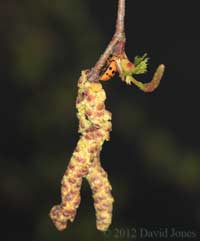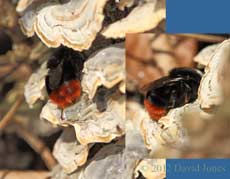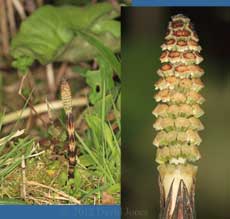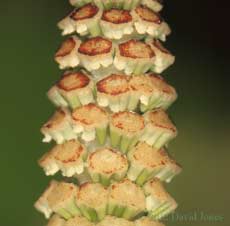Go to the final entry on this page .....Go to previous entry
18 March - As we headed into the second half of the month we had a couple of really grey days. With constant cloud cover, the temperature varied very little. On the 16th it started off at 8C rose just one degree during the day and dropped to 7C during the night. The 17th was little better, although it did reach 10C for much of the afternoon, and there were periods of light drizzle - this had hardly any effect on water depths in the butts. Last night the cloud finally broke up and there was a touch of frost on some cars this morning as we awoke to bright sunshine. Mind you, that didn't mean a warmer day. a high of 10C was only reached for a short time around 1pm, but dropped again as cloud moved in and we had a shower.
After dark the skies cleared, so with no sign of mist and many more stars visible, it gave me another opportunity to search for Comet Garradd. This time I think I have succeeded! Once more, my starting point was the Plough (Ursa Major) as it rose above my neighbour's house. The chart that I mentioned in the previous entry indicated that the comet had now progressed past the two stars at the end of the tail of Draco.
The level of light pollution here means that even after being outside for a while it is very difficult to see any but the brightest stars, especially through the camera viewfinder. However, that pair of stars was visible and once I'd pinpointed them it wasn't long before the images recorded by the camera revealed a fuzzy patch adjacent to a star, and in the 'right place' according to the chart.
A closer look doesn't reveal much more, but at least you can see how the object differs from the relatively sharp streaks created by the stars during a long exposure of around 15 seconds.
My sky watching guide doesn't indicate the presence of a galaxy or nebulae etc. in that immediate area so I'm confident that this is Comet Garradd. However, I need to take another picture of that bit of the sky on the next clear night that we get. If this is the comet then it will have moved elsewhere by then.
19 March - A bright morning with a touch of frost early on. At noon the temperature has reached nearly 13C in the garden under mainly blue skies with scattered cloud. With the forecast suggesting clear skies again tonight I hope to take some more photographs of Comet Garradd. In the meantime I see that pictures of the comet taken last night have been published online on sites such as skyatnight.com , and these confirm that I was correct last night. Still, it will be nice to confirm it for myself with another photograph. Perhaps one day I should invest in an equatorial telescope mount that can be used to move the camera (or/and telescope) in unison with the stars as they rotate around Polaris, and so avoid the elongation seen in my long exposure photographs. Back at garden level, while the sunshine has encouraged a small number of frogs to re-emerge in the ponds there is no sign of any further interest in mating.
20 March - Another bright day with the temperature over 13C for much of the afternoon after a frost-free start. I spent much of the morning and early afternoon sorting out bits at the bottom of the garden before spending a delightful few hours with our grandson. I see that the first of our Marsh Marigolds is on the point of flowering, although the bud seems to have suffered from the attention of a slug! Last night's attempt at recording Comet Garradd was a disaster. The sky was clear but for some reason (probably weariness) I just couldn't point the camera in the right direction. However, tonight I had another chance until cloud rolled in and brought the session to an end. Fortunately, this time the camera 'found' the comet quite quickly. The arrival of the clouds meant I didn't get the chance to switch to the highest available magnifications, but I do have the confirmation I hoped for after the previous session.
Looking just above the tail of Draco it is clear that the fuzzy object that i photographed two nights ago is no longer in that position - the comet has moved on! While adding the large images for this entry I've just spotted that in several pictures Draco is misspelt as Drago - I'm afraid that on our trips to Cornwall we have passed the road signs for Castle Drogo, and shopped in Trago Mills far too often!
This picture shows the comet's position tonight (at 7.47pm) relative to the last pair of stars in the tail of Constellation Draco. The comet appears dimmer now.
And this shows its position relative to Dubha, the brightest of the seven stars that form the Plough (Ursa Major). The composite image also includes what I believe to be a satellite tracking across the corner of the frame during what was a 9 second exposure at just after 7.51pm).
A cropped version of that picture shows Comet Garradd a little clearer,
and a closer look at the satellite track reveals a rather wavy line that suggests to me that the satellite may have been spinning.
21 March - A beautiful day, with the temperature into double figures by 9am and up to at least 16C in the afternoon. It was almost a summer's day, apart from the croaking of frogs. There were several dozen making quite a din around the middle of the day, much to the delight of my two grand-daughters. The youngest one spent ages watching and listening to them as they moved about, saying hello to every one that stopped next to where she stood - and she does a very good croak!
This composite image shows its position at 8.15pm tonight and also where I saw it last night, in relation to Ursa Major.
This is a portion of the image at the left of the above composite, showing the comet more clearly (just about).
I'm not sure if these were natural or derived from aircraft vapour trails, but they brought the session to a premature end with just a few pictures taken.
22 March - No pictures today as much of the day was dedicated to our grand-daughters, but the day's weather needs recording. The temperature was up into double figures soon after 9am. By noon it had reached 17C and peaked at just over 19C in mid-afternoon. At 7pm it was still 12C and at 8.30pm it is still over 11C. This all added up to the hottest day of the year so far, and of course there was no sign of rain! Despite these high temperatures there was some cloud today, and perhaps because of this the frogs remained largely out of sight. There was no repeat of yesterday's performance, and we had to search for any frogs for my youngest grand-daughter to look at.
23 March - With another day before the clocks move to British Summer Time it appears that the weather has rather jumped the gun. It took a little longer for the thermometer to reach double figures this morning, but once it did (by 10am) it was up to 16C by noon before exceeding 19C and hour later. It remained around the 20C mark for the next three hours before dropping to 17C by 5pm and 12C by 9pm. We were looking after our grandson for most of the day and it was a pleasure to be able to spend time in the garden with him - he's nowhere near being ready to pedal, but he had his first taste of riding on a trike (with granddad pushing!), and he loved it! While the two of us were on one of our 'journeys' Sheila spotted our first butterfly of the year, a Brimstone. Checking back on March last year, the weather was following a similar pattern, although we had to wait until the 25th before the temperature hit 20C and the first butterflies (also Brimstones) were seen.
Also two days earlier than in 2011, the first two of the Snake's-head Fritillary flowers opened today. These plants are thriving in the damp soil at the side of the pond and there are quite a few delicate shoots appearing as the area occupied by them expands, especially at the water's edge. I see one flower is about to open on the island in the big pond. I've taken the precaution of putting up a temporary fence around them to protect the area from little feet....
I mentioned the Marsh Marigolds a couple of days ago. The one partly eaten flower has opened completely for the first time today (last year first opening was on the 27th). While it is still the only example, there are numerous flower buds to be seen and I would expect more to open over the coming weekend.
At the bottom of the garden the first of our Bluebells have started flowering. I'm a bit cross with myself. A couple of weeks ago our local garden centre had English Bluebells on sale and I decided not to get them that day. When I finally went to get some they had all gone!
Today saw the bursting of the first buds on our Hawthorn, a couple of days later than last year, and also a couple later than the buds on a Hawthorn sapling that is growing in a pot at the bottom of the garden.
In stark contrast, the buds on our Birch tree remain tightly closed while the male catkins at the tips of most of its branches prepare to shed their clouds of pollen.
Another tree has made a surprise appearance at the front of the house, under the Rosa rugosa plants along our front garden wall. This afternoon I spotted the fresh green leaves of a young Sycamore. This has now been transferred to a pot alongside the Hawthorn, an Oak and two native Birch trees. One day these will be be found more suitable homes!
Having already mentioned our first butterflies, today I also saw the first solitary bee activity of the year, one by a bee hotel and a couple visiting the Lesser Celandine flowers which are opening up all over the place now.
These are also being visited by hoverflies and the occasional bumblebee, such as this White-tailed Bumblebee which I photographed yesterday.
26 March - Those last few days disappeared too quickly with me engaged in a bit more garden maintenance work - I say a bit more because when I look back at what was achieved, I'm sure it could have been done in half the time! And the weather continues in its summer disguise. On the 24th it was well into double figures by 9am and reached a high of 20C by 1pm. Yesterday a high of just 16C (blame that on high level haze) made a noticeable difference if you spent the day outside as I did. Today, after a misty start which kept the temperature below 10C until after 10am (only 4C at 7am) the sky cleared and by mid-afternoon it was just shy of 20C once more.
There are several interesting 'bits' of tree around the garden and during the weekend I noticed that one, which has been sitting under the front edge of the caravan shelter for at least a couple of years, had developed several fungal fruiting bodies consisting of off-white bulbous structures around 3 to 4cm across. Unfortunately, for much of the time my hands were either dirty or paint-stained so I didn't photograph them. However, today (a day off 'work') these had burst open to reveal a mass of chocolate brown spores inside. I have not yet been able to identify them. They appear to be similar to the puff balls, but do not have any stalk at all. I will also need to identify the wood that they're on.
Added 2 June 2012 - Thanks to Nick Aplin of the Sussex Fungi Group I now know that it was not a fungus but a Myxomycete (slime-mould) called Reticularia lycoperdon.
In the last entry I mentioned seeing a couple of solitary bees. Well there were a few more around today, including a couple like this slightly larger and brighter species (possibly Megachile centuncularis). These are very difficult to approach in the bright sunshine.
The bright sunshine is no longer enough to tempt the frogs into energetic activity or even the occasional chorus, and the pond has become a very quiet place once more. While it isn't easy to look closely at the frogspawn because of its location this year, the sample I have in the tank shows that many of the tadpoles will now be free of their gelatinous spheres and are able to swim. I guess that this means the newts will be having their annual feast, although so far I have seen just one of them.
As for the frogs, to see them you usually have to search under the shelter of vegetation to spot an eye peeping out from the duckweed. This individual was the exception today, choosing to emerge next to a young Branched Bur-reed plant.
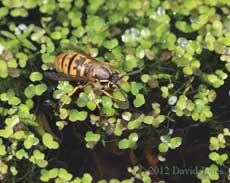
For the frogs it is now a waiting game as they wait for prey to wander into the striking zone of their tongue. With relatively few flying insects about so far they will to rely on things such as crawling insects or worms. However, occasionally a frog in the right place at the right time must be tempted by the arrival of a queen wasp, landing on the duckweed to take a drink. Perhaps the wasps are aware of the potential danger as they usually touch down away from the taller, shadowy vegetation.
Now for the things I didn't photograph. The appearance of Brimstone butterflies is now a daily occurrence, and there was a also a white butterfly here briefly yesterday. This afternoon I saw my first bee-fly of the year - gone by the time I grabbed my camera! Over the last two days I have seen three Sparrowhawk attacks in the garden, all unsuccessful as far as I can tell. All three attacks were by a male. Yesterday he managed to surprise not only the sparrows but two Collared Doves and the pair of Magpies, and for a few minutes there was an unlikely mixture of species hiding in the Hawthorn. The Sparrows scattered to the four corners of the garden, from the bamboo plant next to which I happened to be standing to the small log store on the veranda. This afternoon the attack came while we ate at around 6.30pm. This time the hawk stayed for quite a while, moving from perch to perch at least seven times, each time keeping very still and watching for any bird that was foolish enough to break cover. Talking of birds, If you haven't noticed I have finally made a start on the 2012 Nest Box Diary, and the webcam is up and running to keep watch on a very untidy looking Sparrow nest. You will find the links on the home page.
28 March - Noticeably, the warmest day so far. Farnborough recorded 21C as the afternoon progresses, and I'm sure it was a degree or so warmer in the garden.
Another new flower to report on as the Forget-me-nots start to bloom. They may be small but the variations in colour between blue and pink stand out as the inflorescences open up.
Having caught my first glimpse of a Bee-fly two days ago, this afternoon I think there were a couple about, attracted mainly to the bright yellow of the Dandelions
and the Lesser Celandines. Only a few years ago and these were a rarity in the garden, but now they are Springtime regulars!
Back on the 23rd I mentioned the first Marsh Marigold to flower. In all fairness that flower had been 'encouraged' to open. However, today there was no doubt about this flower opening, the first undamaged bloom.
The frogs seemed even more lethargic today, not even bothering to slip under the surface when I approached them. This one remained in the same spot in the middle of the big pond for over three hours,
and this one kept still for nearly as long at the side of the small pond.
30 March - I will be adding the large images during the weekend Our very warm spell is coming to an end. Today, despite hazy sunshine all day the temperature didn't get much above 16C, although in the garden in the late afternoon it felt warmer as long as you were not in the shade. Between yesterday morning and lunchtime today we had the pleasure of having our grandson stay with us - a perfect little gentleman with always a happy smile for us and and incredibly energetic for a little boy who has yet to crawl! This afternoon we have been relaxing (I nearly said recovering, but to suggest that would be a disservice to him), and today's photographs were all taken as the sun started slipping behind the conifers. I had no time to check on progress in the garden so some of these pictures represent developments that took place over the last two to three days.
First, the first Violets seen this year. In fact I found three open in a spot where there were none two days ago.
Back on the 23rd I mentioned the male catkins on our Himalayan Birch. Well, the first have now started to shed pollen. As the right-hand image shows, the leaf buds are still tightly closed, and this afternoon I was unable to find any female flowers. I will look for these again tomorrow. In contrast, my neighbour's native Birch is turning green (left image). Its catkins have been shedding their pollen for at least the last few days and at the top of the picture you can see a well established red coloured female inflorescence.
Unfortunately, in this case some drastic pruning has meant that as far as I can see this is the only inflorescence in the tree at the moment. If I have a chance I need to take another look tomorrow.
In contrast to the Birch right next to it, the Rowan's leaf buds are opening before its flowers appear. This is one of just a few that I could see as having burst by this afternoon.
The Hazels were given to us by the family that owns the Pinetrees campsite & holiday cottages in Cornwall, and are from trees growing there.
Returning to the Birch tree, to check on the catkins I needed to get up onto my shed roof, and as I photographed the native Birch I caught sight of a Harlequin Ladybird feeding on a catkin. It moved to this more sheltered spot as soon as it detected my presence. I'm sort of surprised that this is the first ladybird of any sort that I've seen during the good weather.
Back down off the roof, a flash of red attracted my attention to the is Red-tailed Bumblebee queen that was investigating between the structures of bracket fungi that cover much of an Apple tree stump that resides next to the shed. Unfortunately I managed to cast a shadow over it with my elbow and it was gone before I could get any more photographs.
I only saw one butterfly today, and that was dark and more or less in silhouette, so I wasn't able to identify it in the few moments it took to fly past.
31 March - The month ended with a cloudy day and a high temperature of just 11C. After a trip out in the morning to organise a new set of tires for our car, the rest of the day was spent in the garden, shifting what remains of our log supply as I prepare the store for next winter's deliveries. Mind you, today's chill meant that we ended up burning some of those logs! By the end of the day I had no doubt that the trees around us are now shedding their pollen - the 'hay-fever' season is upon me!
Just one new sighting in the garden today. By the side of the big pond has appeared this horsetail bearing a cone shaped strobilus, a structure that produces spores. While I didn't record seeing one produced here last year, I did see one in exactly the same place in 2010, only that one didn't appear until 17 April. I think the species may be Equisetum telmateia.
The strobilus (which is hollow) has whorls of umbrella shaped sporangiophores, seen here with a reddish tinge, and attached to each of these are a number of sporangia. Each one (a sporangium) produces what are quite complicated spores which have four appendages which react to the moisture in the air by twisting and turning. I must find out more about this.
Click on images to see larger versions
|
|
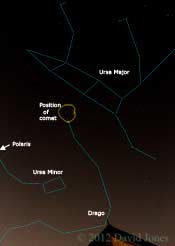
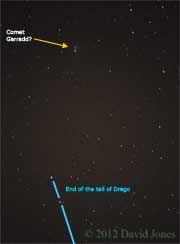
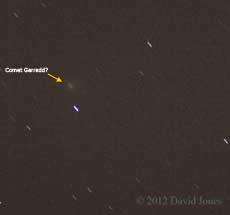
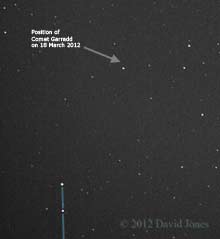
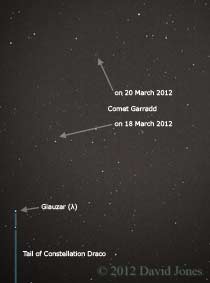
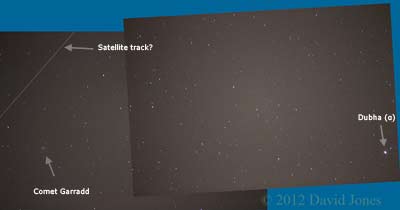
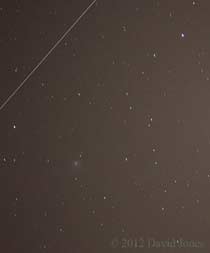
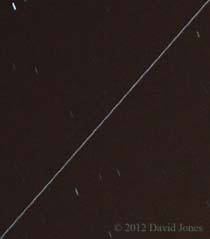
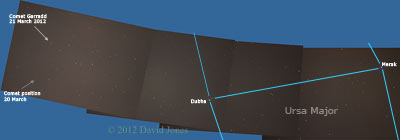
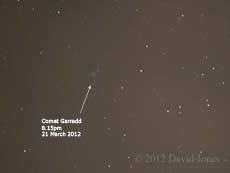
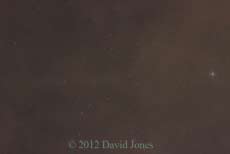
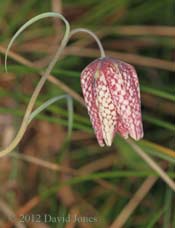
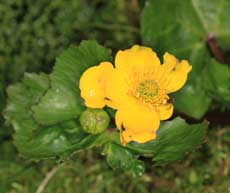
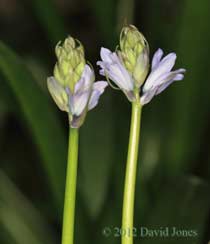
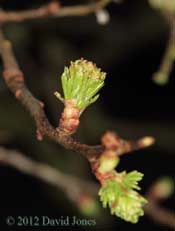
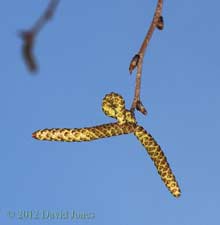
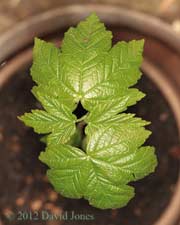
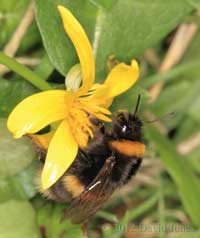
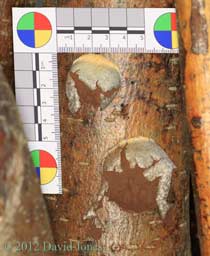
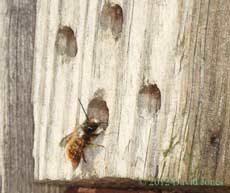
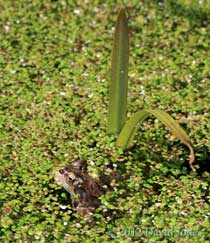
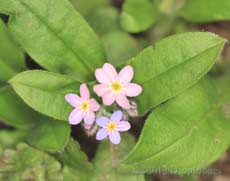
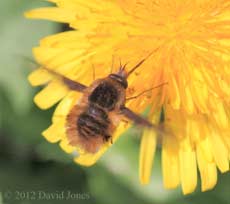
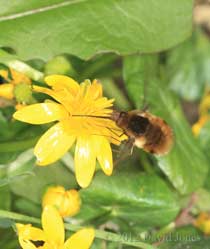
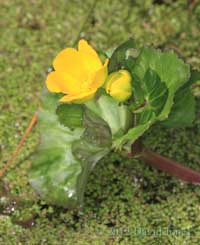
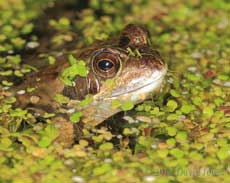
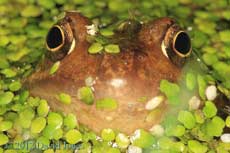
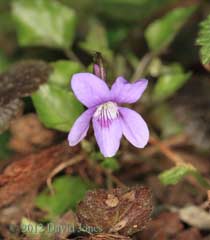
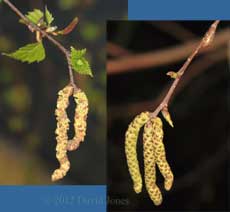
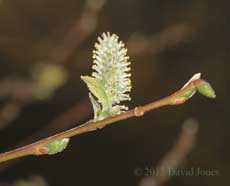 Trees
like these need to cast their wind blown pollen before the foliage develops
to create an obstruction. This seems also the case for the (pot-bound)
Willow by the side of the big pond.
Trees
like these need to cast their wind blown pollen before the foliage develops
to create an obstruction. This seems also the case for the (pot-bound)
Willow by the side of the big pond. 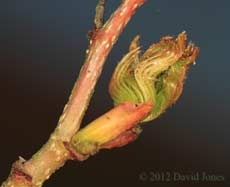
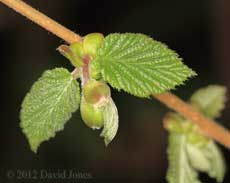 Along
side the 'Ivy tree' we have two young Hazels destined to fill the gap when I
finally need to remove the Ivy. The Hazels are not yet mature enough to
flower and this afternoon I see that one is more advanced that the other in
that just its buds have burst so far. As for any flowers, I will need to
look out for them from Autumn onwards.
Along
side the 'Ivy tree' we have two young Hazels destined to fill the gap when I
finally need to remove the Ivy. The Hazels are not yet mature enough to
flower and this afternoon I see that one is more advanced that the other in
that just its buds have burst so far. As for any flowers, I will need to
look out for them from Autumn onwards.